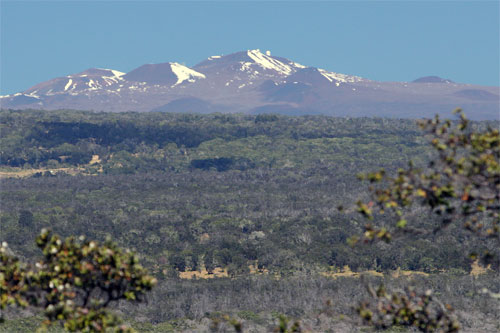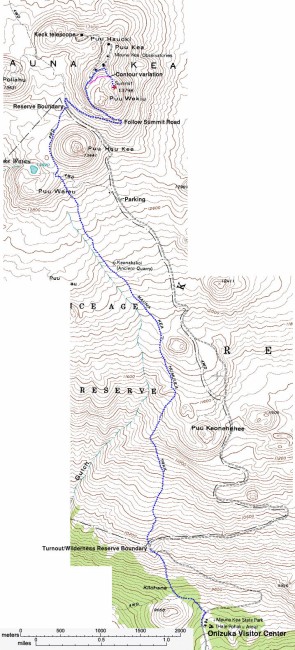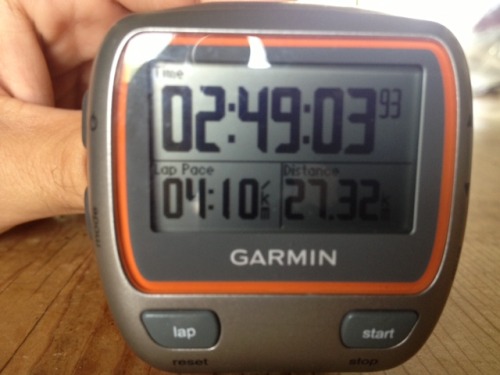Post by Peter Bakwin on Nov 11, 2009 21:00:19 GMT -5
Mike Bailey did the round-trip (from the Visitor Center) in about 4h, September 16, 2007.
Jorge Maravilla ran the round-trip in 2h51m26s on June 5, 2012.
Fabian Eberhard ran RT from the VC in 2h49m4s on October 15, 2012.
Mike Popejoy has the ascent and RT FKTs from the VC, 1h33m29s ascent and 2h35m05s RT, March 19, 2016.
Randy Harve has the Sea-to-Summit FKT for Mauna Kea (from Hilo), 11h21m45s on October 27, 1990.
Mauna Kea (13,796 feet) is the highest point in Hawaii, and the highest point in the Pacific. If you count the part of the mountain that is underwater, it is the tallest mountain in the world!
Most hikers start from the Ellison Onizuka Visitor center at 9,000 feet elevation on the south side of the peak, which is accessible by a paved road. Above the Visitor Center, a 4WD road continues to the Mauna Kea Observatory, just below the summit. Hikers use the Mauna Kea Trail, which follows an abandoned dirt road, to ascend 4,800 feet over 6 miles to the top.
Mike Bailey reports having run from the Visitor Center to the summit and back, via the auto road, in 4h "give or take a minute", on Sept. 16, 2007. According to Bailey, the road route is 9 miles each way. He started his run at 11:20 a.m., reached the summit at 1:55 p.m. (2h35m), and ran back down the road, arriving at the Visitor Center at 3:20 p.m. (1h25m). "Mauna Kea does not have record of a faster circuit time, although elite athletes should be able to go considerably faster. They just need to vacation in Hawaii more," he said. His blog post on the trip, written 2 years later, is here.
Bailey explained some of the difficulties of ascending Mauna Kea on foot: "Unlike other mountains, like in Colorado, you are already at 6,000 ft when you begin your attempt. Thus, you have already spent time acclimating to the altitude. Most visitors, like myself, in Hawaii begin their day at sea level. My body experienced 0 ft to 13,796 ft in under 6 hours. This can cause numerous health problems, and thus the many stern warnings to visitors about hiking even a small part of the trail. Aside from the altitude issues, it is a very steep trail with a lot of climate change. The temperature during my run varied from 70 degrees at the start to 36 at the summit, with wind, fog, and rain." Bailey chose to use the auto road route, instead of the considerably shorter hiking trail, because "I guess I wanted to try the longer route. Ultrarunner mentality. If there's a shorter way, don't take it." "My wish is for runners to see my time, and set out to break it," Bailey added. "Plus I can't think of too many more beautiful places to run."
As reported below, on June 5, 2012, Jorge Maravilla ran from the Visitor Center to the top in 1h44m, hung around on the summit of a while, then ran back down in 52m. According to Maravilla's data posted to www.strava.com/activities/10726658, the total round-trip time was 2h51m26s. We note here that round-trip times definitely include any time spent on the summit. Fabian Eberhard beat Maravilla's RT time on 15 October 2012 by spending less time on the summit. Eberhard ascended in 1h55m and descended in 54m, reporting (below) a total time of 2h49m04s. Mike Popejoy set new ascent and RT FKTs on March 19, 2016 (1h33m29s up, 2h35m05s RT), as reported below.
Mike Hotchkis reports (below) running "Sea to Summit" on Mauna Kea in 14h00m on 20 April 2015. Hotchkis started in Hilo. He gives info below on some past Sea-to-Summit runs. It appears the overall FKT for this was set by Randy Harve on 27 October 1990, 11h21m45s, also starting from Hilo. This was posted to the H.U.R.T. blog.
Billy Barnett appears to have run about the same time (4 hours) as Bailey for a longer (24 mile) route starting at around 6,500 feet, on Oct. 21, 2011. But, we don't have confirmation of the time or route, so can't consider this an FKT. Barnett was inspired to pen these lines after the run:
"Mauna Kea’s Starry Songs" by Billy Barnett
Hard times in the city
God damn
Hard times in the country
Left the dishes in the sink and
I’m going up a mountain
Heard the wild thieves are on the hunt
Trying to steal my heart
So I’m a' high flyin' up
Balancing on a thought and
Singing starry songs
Sung through my hearts voice while i'm
Stumbling and weary from the riddles
Yet harmoniously
In the midst of joy
Lookin’ for the right kind of love
To come and take me back down but
For now I’m just a’ high flyin’ up
Don’t know when I’m coming back down
Jorge Maravilla ran the round-trip in 2h51m26s on June 5, 2012.
Fabian Eberhard ran RT from the VC in 2h49m4s on October 15, 2012.
Mike Popejoy has the ascent and RT FKTs from the VC, 1h33m29s ascent and 2h35m05s RT, March 19, 2016.
Randy Harve has the Sea-to-Summit FKT for Mauna Kea (from Hilo), 11h21m45s on October 27, 1990.
Mauna Kea (13,796 feet) is the highest point in Hawaii, and the highest point in the Pacific. If you count the part of the mountain that is underwater, it is the tallest mountain in the world!
Most hikers start from the Ellison Onizuka Visitor center at 9,000 feet elevation on the south side of the peak, which is accessible by a paved road. Above the Visitor Center, a 4WD road continues to the Mauna Kea Observatory, just below the summit. Hikers use the Mauna Kea Trail, which follows an abandoned dirt road, to ascend 4,800 feet over 6 miles to the top.
Mike Bailey reports having run from the Visitor Center to the summit and back, via the auto road, in 4h "give or take a minute", on Sept. 16, 2007. According to Bailey, the road route is 9 miles each way. He started his run at 11:20 a.m., reached the summit at 1:55 p.m. (2h35m), and ran back down the road, arriving at the Visitor Center at 3:20 p.m. (1h25m). "Mauna Kea does not have record of a faster circuit time, although elite athletes should be able to go considerably faster. They just need to vacation in Hawaii more," he said. His blog post on the trip, written 2 years later, is here.
Bailey explained some of the difficulties of ascending Mauna Kea on foot: "Unlike other mountains, like in Colorado, you are already at 6,000 ft when you begin your attempt. Thus, you have already spent time acclimating to the altitude. Most visitors, like myself, in Hawaii begin their day at sea level. My body experienced 0 ft to 13,796 ft in under 6 hours. This can cause numerous health problems, and thus the many stern warnings to visitors about hiking even a small part of the trail. Aside from the altitude issues, it is a very steep trail with a lot of climate change. The temperature during my run varied from 70 degrees at the start to 36 at the summit, with wind, fog, and rain." Bailey chose to use the auto road route, instead of the considerably shorter hiking trail, because "I guess I wanted to try the longer route. Ultrarunner mentality. If there's a shorter way, don't take it." "My wish is for runners to see my time, and set out to break it," Bailey added. "Plus I can't think of too many more beautiful places to run."
As reported below, on June 5, 2012, Jorge Maravilla ran from the Visitor Center to the top in 1h44m, hung around on the summit of a while, then ran back down in 52m. According to Maravilla's data posted to www.strava.com/activities/10726658, the total round-trip time was 2h51m26s. We note here that round-trip times definitely include any time spent on the summit. Fabian Eberhard beat Maravilla's RT time on 15 October 2012 by spending less time on the summit. Eberhard ascended in 1h55m and descended in 54m, reporting (below) a total time of 2h49m04s. Mike Popejoy set new ascent and RT FKTs on March 19, 2016 (1h33m29s up, 2h35m05s RT), as reported below.
Mike Hotchkis reports (below) running "Sea to Summit" on Mauna Kea in 14h00m on 20 April 2015. Hotchkis started in Hilo. He gives info below on some past Sea-to-Summit runs. It appears the overall FKT for this was set by Randy Harve on 27 October 1990, 11h21m45s, also starting from Hilo. This was posted to the H.U.R.T. blog.
Billy Barnett appears to have run about the same time (4 hours) as Bailey for a longer (24 mile) route starting at around 6,500 feet, on Oct. 21, 2011. But, we don't have confirmation of the time or route, so can't consider this an FKT. Barnett was inspired to pen these lines after the run:
"Mauna Kea’s Starry Songs" by Billy Barnett
Hard times in the city
God damn
Hard times in the country
Left the dishes in the sink and
I’m going up a mountain
Heard the wild thieves are on the hunt
Trying to steal my heart
So I’m a' high flyin' up
Balancing on a thought and
Singing starry songs
Sung through my hearts voice while i'm
Stumbling and weary from the riddles
Yet harmoniously
In the midst of joy
Lookin’ for the right kind of love
To come and take me back down but
For now I’m just a’ high flyin’ up
Don’t know when I’m coming back down
  |  |

 . As near as we can tell, he broke the current "fastest known time" by a massive 89 minutes.
. As near as we can tell, he broke the current "fastest known time" by a massive 89 minutes. 
